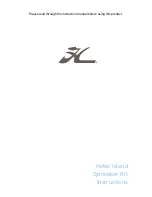
ENGLISH
30
5.10.4 Anchoring, mooring and towing
Always anchor your boat carefully even in sheltered spots, as
conditions can change suddenly. The mooring line should be
equipped with a spring-loaded device to cushion the effect of jerk-
ing. See the attaching points in Diagram 8. Do not use other parts
of the boat for mooring, towing, or anchoring. Use sufficiently
large fenders to avoid chaffing and friction.
The eyelet on the prow is meant for docking on a slipway or
mounting on a trailer, not for pulling the boat sideways when
mooring to a jetty. The boat also has a thief-proof, hardened-steel
eyelet attached to the foredeck, which is intended for a locking
chain only and should not be used for any purpose other than
locking the boat.
The strength of the attaching points is also shown in Diagram 8.
It is the responsibility of the owner/user to ensure that mooring,
towing and anchor ropes, anchor chains and anchors are appro-
priate for use on the boat and that the breaking strength of the
ropes and chains does not exceed 80% of the strength of the cor-
responding attaching point. However, rope wear and knots that
weaken the strength of ropes should also be kept in mind.
When anchoring in a natural harbour, ensure, for instance with
a plumb line, that the depth of the water is sufficient and that
you DROP ANCHOR AT A SUFFICIENT DISTANCE FROM THE
SHORE. A reasonable grip can be achieved when the rope is 4–5
times the water depth. The grip also gets better the more the rope
is extended. Grip also improves significantly if the first 3–5 metres
of the anchor rope is weighted rope or chain.
WARNING!
Do not try to stop the boat’s motion by using your
hand or placing your hand or foot between the boat
and the jetty, the shore, or another boat. Practise
mooring and anchoring in good conditions and use
engine power with restraint but resolutely.
















































